Talking HTTP
Intro to Web Modules
Me
- I work at uStudio.
- We make video management easy.
- We are always looking for a few good devs.
WSGI
Web Server Gateway Interface
Why Do You Care?
Web applications are just interfaces
Browsers are ubiquitous GUI frameworks (tk sucks)
Managing cloud operations (beats screen sessions)
WSGI is a PEP. (You want to know them all, right?)
Pronunciation
Some people pronounce it "Whiz-gi".
(rhymes with whiskey)
I don't.
Web Servers for Non-Webheads
HTTP is simple in theory.
Accept a socket connection
Parse request payload
Generate response
Buffer response payload
Close socket
Request Example
POST /articles HTTP/1.1
User-Agent: my-awesome-client/1.3
Content-Type: application/json
Content-Length: 49
Host: www.myblog.com
Accept: */*
{"title": "foobar", "content": "This is a post."}
Response Example
HTTP/1.1 201 Created
Date: Wed, 10 Jul 2013 02:03:00 GMT
Expires: -1
Content-Type: application/json
Content-Length: 37
{"status": 201, "message": "created"}
The Reality
sock = socket(AF_INET, SOCK_STREAM)
sock.bind(("", 8080))
sock.listen(5)
while True:
(client, address) = sock.accept()
body = client.recv(BUFFER_SIZE)
while "\r\n\r\n" not in body:
body += client.recv(BUFFER_SIZE)
headers, body = body.split("\r\n\r\n")
method, path, headers = extract_headers(headers)
content_length = int(headers["content-length"]) - len(body)
if content_length:
body += client.recv(content_length - len(body))
client.send(handle_request(method, path, headers, body))
client.close()
Lots of Concerns...
- thread pool
- non-blocking
- routing
- special headers
- keep alive
- buffering
- network issues
- static files
- caching
- middleware
- ssl
- stability
- proxies
- expiration
- range requests
Not Invented Here
The year was 2003...
The dark ages of Python on the web.
Everybody rolled their own thing.
Twisted Web, Zope, Webware, etc.
Custom servers, CGI, "proprietary" middleware...
Open-source vendor lock in
Enter WSGI
Stupid-Simple Standard
Ideas of WSGI
Took cues from Java servlet standardization
Minimal design implications for existing frameworks
Extensible for future hotness
Easy to understand / work with for (early) adopters.
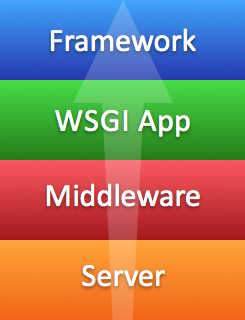
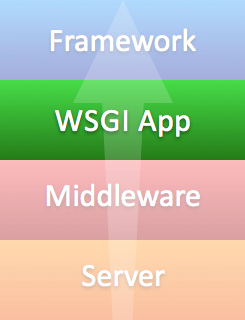
WSGI is a function
The most basic app just takes two arguments.
environis a dictionary of request informationstart_responsehandles... starting the response.- The return value is an iterable of strings.
WSGI is a function
def application(environment, start_response):
status = "200 OK"
headers = [("Content-Type", "application/json")]
body = json.dumps({"status": 200, "message": "ok"})
start_response(status, headers)
yield body
environ contains... a lot.
- Apple_PubSub_Socket_Render: /tmp/launch-XuHI0f/Render
- Apple_Ubiquity_Message: /tmp/launch-SdX70z/Apple_Ubiquity_Message
- COMMAND_MODE: unix2003
- CONTENT_LENGTH: 21
- CONTENT_TYPE: application/json
- DISPLAY: /tmp/launch-yI0RmK/org.macosforge.xquartz:0
- GATEWAY_INTERFACE: CGI/1.1
- HOME: /Users/jmarshall
- HTTP_ACCEPT: */*
- HTTP_ACCEPT_ENCODING: gzip,deflate,sdch
- HTTP_ACCEPT_LANGUAGE: en-US,en;q=0.8
- HTTP_CONNECTION: keep-alive
- HTTP_HOST: localhost:8000
- HTTP_ORIGIN: http://localhost:8000
- HTTP_REFERER: http://localhost:8000/
- HTTP_USER_AGENT: Mozilla/5.0 (Macintosh; Intel Mac OS X 10_8_4)
- ITERM_PROFILE: Default
- ITERM_SESSION_ID: w0t1p1
- LANG: en_US.UTF-8
- LOGNAME: jmarshall
- MXMLC_PATH: ~/bin/flex/bin/mxmlc
- OLDPWD: /Users/jmarshall/Presentations/APUG-20130709/code
- PATH:
- PATH_INFO: /process
- PWD: /Users/jmarshall/Presentations/APUG-20130709/code/wsgi_process
- QUERY_STRING:
- REMOTE_ADDR: 127.0.0.1
- REMOTE_HOST: 1.0.0.127.in-addr.arpa
- REQUEST_METHOD: POST
- SCRIPT_NAME:
- SECURITYSESSIONID: 186a5
- SERVER_NAME: josh-macbook-pro.local
- SERVER_PORT: 8000
- SERVER_PROTOCOL: HTTP/1.1
- SERVER_SOFTWARE: WSGIServer/0.1 Python/2.7.2
- SHELL: /bin/bash
- SHLVL: 1
- SSH_AUTH_SOCK: /tmp/launch-4QZWdj/Listeners
- TERM: xterm
- TERM_PROGRAM: iTerm.app
- TMPDIR: /var/folders/f_/7fnqd5r14zngq914cxzt_6q00000gn/T/
- USER:
- VERSIONER_PYTHON_PREFER_32_BIT: no
- VERSIONER_PYTHON_VERSION: 2.7
- VIRTUALENVWRAPPER_HOOK_DIR: /Users/jmarshall/.virtualenvs
- VIRTUALENVWRAPPER_PROJECT_FILENAME: .project
- WORKON_HOME: /Users/jmarshall/.virtualenvs
- _: /usr/bin/python
- __CF_USER_TEXT_ENCODING: 0x1F5:0:0
- wsgi.errors: <open file '<stderr>', mode 'w' at 0x1069ee270>
- wsgi.file_wrapper: wsgiref.util.FileWrapper
- wsgi.input: <socket._fileobject object at 0x106aec7d0>
- wsgi.multiprocess: False
- wsgi.multithread: True
- wsgi.run_once: False
- wsgi.url_scheme: http
- wsgi.version: (1, 0)
Valuable Keys
Some of the more valuable entries in environ
- PATH_INFO: Contains the path part of a URL
- REQUEST_METHOD: "GET", "POST", etc.
- QUERY_STRING: Everything past the ?
- REMOTE_ADDR: The client IP address
- wsgi.input: File-like object (request body)
WSGI is a callable
Raw WSGI makes simple apps very easy
Makes complex apps... interesting.
Most modern frameworks support this at the core.
Most abstract away the application itself.
Request and response objects, templating...
More Complicated Example
Show JSON Example
Complications Arise
- Raw WSGI is great if you want to...
- roll your own routing
- parse request arguments yourself
- tightly control body parsing
- intercept and redirect application behavior
- rule your own world
- tear all your hair out
- It's a bad choice if you want to just 'get stuff done'.
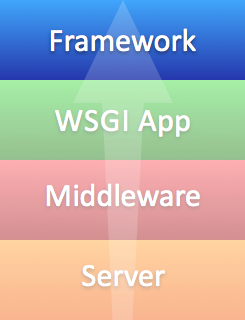
WSGI is an adapter
Really, WSGI enables frameworks.
Abstract container, support custom interfaces.
Most basic are wrappers like WebOb and Werkzeug
Simple frameworks like Flask to monsters like Django.
Roll Your Own
There are a lot of pieces out there.
Use what you know, or what you want to learn.
Jinja2, Cheetah, Mako, etc. for templates.
SQLAlchemy, Storm, MongoEngine, etc. for models.
Werkzeug, custom regex, etc. for routing.
Custom Router
Example of Simple "Roll Your Own"
Use Frameworks that Support WSGI
It's hard to find a framework that DOESN'T.
Your usage may constrain what frameworks to use.
Limited dependencies? Raw WSGI.
Simple APIs? Flask.
Content management / massive app? Django.
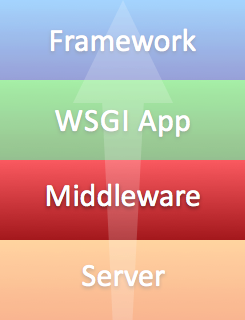
Middleware Changes Things
One of the more powerful aspects of WSGI
You can nest apps.
Environ can be modified.
You can call start_response multiple times.
This means, you can intercept and change things.
Simple Proxy Example
def proxy_host(app):
def proxy_app(environ, start_response):
if "HTTP_X_FORWARDED" in environ:
environ["REMOTE_ADDR"] = environ["HTTP_X_FORWARDED"]
return app(environ, start_response)
return proxy_app
@proxy_host
def application(environ, start_response):
# do actual stuff...
Extending Environ
Some WSGI adapters extend functionality.
# wrapped with gevent's websocket handler
def websocket_app(environ, start_response):
socket = environ["wsgi.websocket"]
socket.send(json.dumps({"foo": "bar"})
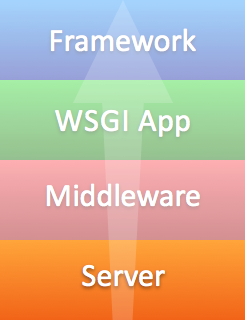
Servers
There are LOTS of WSGI deployment options.
gevent, mod_wsgi, gunicorn, cgi...
Depends on what you want to do.
Frequently middleware will be involved.
WSGIREF Example
For development ONLY
from wsgiref.simple_server import make_server
def app(environ, start_response):
start_response("200 OK", [("Content-Type", "text/json")])
yield "Hello World!"
server = make_server("", 8000, app)
server.serve_forever()
Simple Gunicorn Example
Running an existing app
Links
IF you want to do raw WSGI... wsgiref
Werkzeug utilities are very helpful
Heroku deployment is easy here.
Questions?
@joshmarshall on the Twitters.
@joshmarshall on the GitHub.